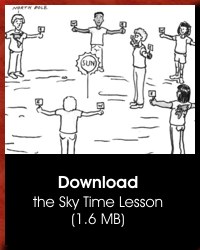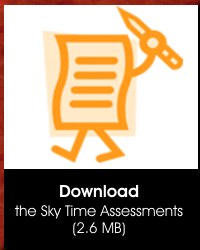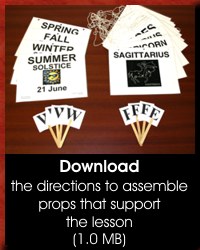Kinesthetic Astronomy
Here we present a significant upgrade to the first in a series of innovative, experiential lessons we call Kinesthetic Astronomy. The Sky Time lesson reconnects students with the astronomical meaning of the day, year, and seasons. Like all Kinesthetic Astronomy lessons, it teaches basic astronomical concepts through choreographed bodily movements and positions that provide educational sensory experiences.
Kinesthetic Astronomy lessons are science-rich and fun. They are intended for sixth graders up through adult learners in both formal and informal educational settings. They emphasize astronomical concepts and phenomenon that people can readily encounter in their "everyday" lives such as time, seasons, and sky motions of the Sun, Moon, stars, and planets.
Kinesthetic Astronomy lesson plans are fully aligned with national science education standards, both in content and instructional practice. Our lessons offer a complete learning cycle with written assessment opportunities now embedded throughout the lesson.
Field testing with non-science undergraduates, middle school science teachers and students, Junior girl scouts, museum education staff, and outdoor educators has been providing evidence that kinesthetic astronomy techniques allow learners to achieve a good intuitive grasp of concepts that are much more difficult to learn in more conventional ways such as via textbooks or even computer animation.
We hope you will enjoy our efforts to make the Sky Time lesson more accessible and useful to you and your students.
Lesson 1: Sky Time LESSON DESCRIPTION:
Modern everyday association with time involves watches, clocks, and calendars instead of the astronomical motions that were the original bases for time keeping. Through a series of simple body movements, students gain insight into the relationship between time and astronomical motions of Earth (rotation about its axis, and orbit around the Sun), and also about how these motions influence what we see in the sky at various times of the day and year. The lesson can be applied to understand the times of day and year on other planets (e.g. Mars). The lesson can be taught with or without an emphasis on the reasons for seasons, but in any case is an excellent set-up for understanding seasons.
AUDIENCE:
Middle school ages and up.
LOCATION/SETTING:
An indoor or outdoor space large enough for your students to form a circle with arms outstretched to their sides. For a class of 25-30 students one needs a space whose size is about half a basketball court. This lesson is best with at least eight students participating.



